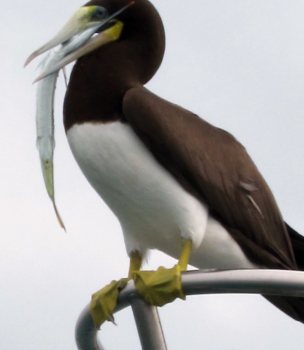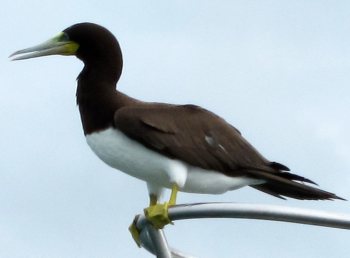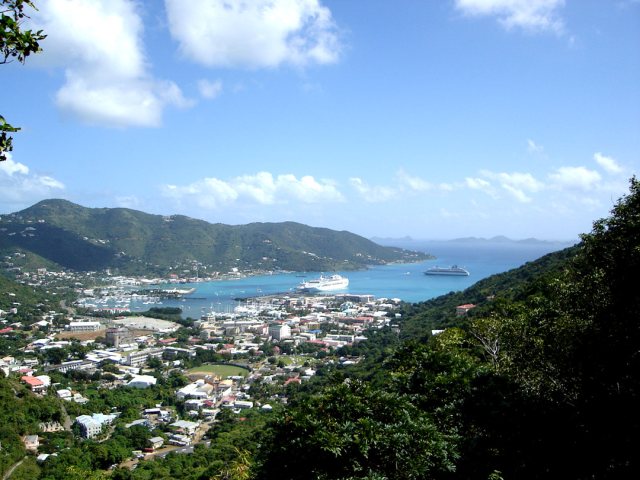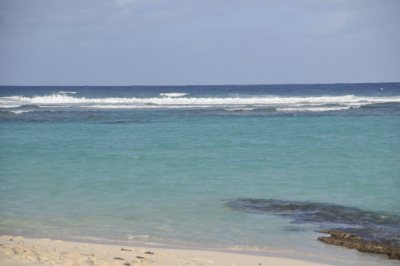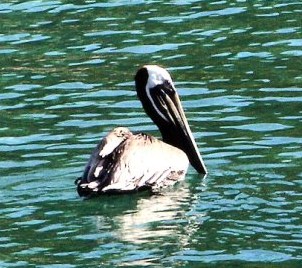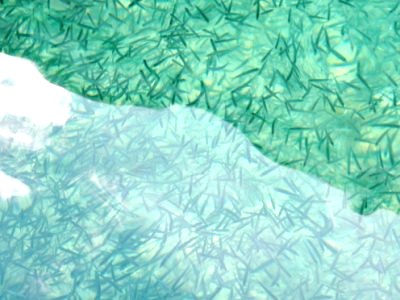|
The British Virgin Islands
The
BVI’s are a British overseas territory, located in the Caribbean to the
east of Puerto Rico. Technically the name of the
Territory is simply the "Virgin Islands", but in practice since 1917 they have
been almost universally referred to as the "British Virgin Islands" to
distinguish the islands from the American Territory. To add to the regional
confusion, the Puerto Rican islands of Culebra, Vieques
and surrounding islands began referring to themselves as the "Spanish Virgin
Islands" as part of a tourism drive in the early
2000's.
The
British Virgin Islands consist of the main islands of Tortola, Virgin
Gorda,
Anegada and Jost Van Dyke, along with
over fifty other smaller islands and cays. Approximately
fifteen of the islands are inhabited. The largest island, Tortola, is
approximately approximately twelve miles long and three miles
wide. The islands have a total population of about 22,000, (about 18,000 live on
Tortola). Road Town, the capital, is situated on
Tortola.

History: The Virgin Islands were
first settled by the Arawak from South America around 100 BC
(though there is some evidence of Amerindian presence on the
islands as far back as 1500 BC). The Arawaks inhabited the islands until the
fifteenth century when they were displaced by the more aggressive
Caribs, a tribe from the Lesser
Antilles islands, after whom the Caribbean
Sea is named.
The
first European sighting of the Virgin Islands was by Christopher Columbus
in 1493 on his second voyage to the Americas. Columbus gave them the
fanciful name Santa Ursula y las Once
Mil Vírgenes (Saint Ursula and her 11,000 Virgins), shortened to Las
Vírgenes (The Virgins), after the legend of Saint Ursula.
The
Spanish Empire claimed the islands by discovery in the
early sixteenth century, but never settled them, and subsequent years saw the
English, Dutch, French, Spanish and Danish all jostling for control of the
region, which became a notorious haunt for pirates. There is no record of any
native Amerindian population in the British Virgin Islands during this period,
although the native population on nearby St. Croix was
decimated.
The
Dutch established a permanent settlement on the
island of Tortola by 1648. In 1672, the English
captured Tortola from the Dutch, and the British annexation of Anegada
and Virgin Gorda followed in 1680. Meanwhile, over the
period 1672–1733, the Danish gained control of the nearby islands of St.
Thomas, St. John and St.
Croix.
The
British islands were considered principally a strategic possession, but were
planted when economic conditions were particularly favourable. The British
introduced sugar cane which was to become the main crop and
source of foreign trade, and slaves were brought from Africa
to work on the sugar cane plantations. The islands prospered economically until
the middle of the 1800's, when a combination of the abolition of slavery in the
Territory, a series of disastrous hurricanes, and
the growth in the sugar beet crop in Europe and the US significantly reduced sugar cane production and led to a period of
economic decline.
In
1917, the US purchased St. John, St. Thomas and St. Croix
from Denmark for US$25 million, renaming them the USVI's.
The
British Virgin Islands were administered variously as part of the British
Leeward Islands or with St. Kitts and Nevis,
with an Administrator representing the British Government on the Islands.
Separate colony status was gained for the Islands in 1960 and the Islands became
autonomous in 1967. Since the 1960's, the islands have diversified away from
their traditionally agriculture-based economy towards tourism and financial
services, becoming one of the wealthiest areas in the
Caribbean.

Geography: The BVI's comprise around
sixty tropical Caribbean islands, ranging in size from the largest, Tortola, to
tiny uninhabited islets. They are located in the Virgin Islands
Archipelago, a few miles east of the US Virgin
Islands. The North Atlantic Ocean lies to the
north of the islands, and the Caribbean Sea lies to the
south. Most of the islands are volcanic in origin and have a hilly, rugged
terrain. Anegada is geologically distinct from the rest of the group and is a
flat island composed of limestone and coral.
In
addition to the four main islands of Tortola, Virgin Gorda, Anegada and Jost Van
Dyke, other islands include: Beef, Cooper, Ginger, Great
Camanoe, Great Thatch, Mosquito, Norman, Peter and Salt. Guana and Necker
Islands (privately owned)
Have look, grab the fish, swallow and
enjoy. The wildlife here have a fantastic life
Climate: The BVI's enjoy a
tropical climate, moderated by trade winds. Temperatures
vary little throughout the year. In the capital, Road Town,
typical daily maxima are around 32 °C in the summer and 29
°C in the winter. Typical daily minima are around 24 °C
in the summer and 21 °C in the winter. Rainfall averages about 45 inches
per year, higher in the hills and lower on the coast. Rainfall can be quite
variable, but the wettest months on average are September to November and the
driest months on average are February and March. Hurricanes occasionally hit the
islands, with the hurricane season running from June to
November.
Politics: Executive authority in
British Virgin Islands is invested in The Queen and is
exercised on her behalf by the Governor of the British Virgin Islands.
The Governor is appointed by the Queen on the advice of the British
Government. Defence and Foreign Affairs remain the
responsibility of the United Kingdom. There is a unicameral
Legislative Council made up of 13
seats.
Road Town from the hills
above
The
British Virgin Islands enjoys one of the more prosperous economies of the
Caribbean region, with a per capita GDP of around $38,500
(2004 est).
In
the British Virgin Islands it has long been fashionable to talk about the "twin
pillars" of the Territory's economy – tourism and financial services.
Politically, tourism is the more important of the two, as it employs a greater
number of people within the Territory, and a larger proportion of the businesses
in the tourist industry are locally owned, as are a number of the highly
tourism-dependent sole traders (e.g. taxi drivers and street vendors).
Economically, however, financial services are by far the more important. Nearly
50% of the Government's revenue comes directly from licence fees for offshore
companies, and considerable further sums are raised directly or indirectly from
payroll taxes relating to salaries paid within the trust industry sector (which
tend to be higher on average than those paid in the tourism
sector).
Tourism accounts for 45% of national income. The
islands are a popular destination for U.S. citizens, with around 350,000
tourists visiting annually (1997 figures). Tourists frequent the numerous white
sand beaches, visit The Baths on Virgin Gorda, snorkel the coral
reefs near Anegada, or experience the
well-known bars of Jost Van Dyke. The BVI'S are known as one of the world's
greatest sailing destinations, charter sailboats are a very popular way to
visit less accessible islands, we chartered a Footloose bareboat in 2003
to see if the cruising life was for us. Every year since 1972 the BVI'S has
hosted the Spring Regatta, which is a seven-day collection of sailing races
throughout the islands. A substantial number of the tourists who visit the BVI'S
are cruise ship passengers, although they produce far
lower revenue per head than charter boat tourists and hotel based tourists. They
are nonetheless important to the substantial (and politically important) taxi
driving community.
Substantial revenues are also generated by the registration of offshore
companies. As of 2004, over 550,000 companies were
so registered. In 2000 KPMG reported in its survey of offshore
jurisdictions for the UK government
that over 41% of the world's offshore companies were formed in the BVI's. Since
2001, financial services in the BVI's have been regulated by the independent
Financial Services Commission.
Agriculture and industry account for only a small proportion of the
islands' GDP. Agricultural produce includes fruit, vegetables, sugar cane,
livestock and poultry, and industries include rum distillation, construction and
boatbuilding.
Since 1959, the official currency of the BVI's has been the US
Dollar, also used by the USVI's.
The
BVI's are a major target for drug traffickers, who use the area as a gateway to
the US. According to the Foreign & Commonwealth Office, drug trafficking is
"potentially the most serious threat to stability in the
BVI'S".
Some of the most beautiful beaches in the
world, with the cleanest, clearest waters in the
world
Demographics: The population of the
Islands is around 21,730 in 2003. The majority of the population (83%) are
Afro-Caribbean, descended from the slaves brought to the
islands by the British. Other large ethnic groups include those of British and
other European origin. The 1999 census reports:
83.36% Black, 7.28% White*, 5.38% Mixed, 3.14% East Indian and 0.84% Others
*
includes British, Portuguese, Spanish, and
Syrian/Lebanese.
The
islands are predominantly Protestant Christian
(86%). The largest individual Christian denominations are Methodist
(33%), Anglican (17%), and Catholic
(10%). The primary language is English, with a quick creole
accent.
The number plates here have the wonderful words "Nature's Little Secrets"
Transport: There are seventy miles
of roads. The main airport (Terrance B. Lettsome International Airport,
also known as Beef Island Airport) is located on Beef Island, which lies off the
eastern tip of Tortola and is accessible by the Queen Elizabeth II Bridge.
Virgin Gorda and Anegada have their own smaller airports. The main harbour is in
Road Town. There are also ferries that operate
within the BVI's and to the neighbouring USVI's. As in the UK,
cars in the BVI's drive on the left side of the road. The roads are often quite
steep and winding, and ruts can be a problem when it
rains.
Education: The BVI's operates
several government schools as well as private schools. There is also a community
college, Hamilton Lavity Stoutt Community College that is located on the eastern
end of Tortola. This college was named after the late Honourable Lavity Stoutt
(Chief Minister).
Music: The traditional music of the BVI's is
called fungi after the local cornmeal dish with the same name, often made with okra. The special sound of fungi is due
to a unique local fusion between African and European music. It functions as a
medium of local history and folklore and is therefore a cherished cultural form
of _expression_ that is part of the curriculum in BVI schools. The fungi bands,
also called "scratch bands", use instruments ranging from calabash, washboard, bongos and ukelele, to more traditional western instruments like
keyboard, banjo, guitar, bass, triangle and saxophone. Apart from being a form
of festive dance music, fungi often contains humorous social commentaries, as
well as BVI oral history.
Pelicans are plentiful but so is their food in the cristal clear waters of the
BVI's
ALL IN ALL AMAZING TO RETURN HERE AFTER SIX YEARS THIS TIME ON OUR OWN
BEEZ NEEZ
|





